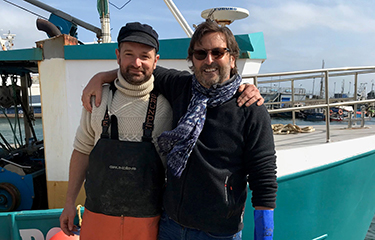COVID-19 crisis drives European producers to trial new ways to sell seafood

The COVID-19 pandemic has had a monumental impact on global seafood trade.
Fishing fleets are tied up and fish farmers are facing an ever-increasing biomass in their cages, ponds, and tanks. Transport links all over the world have been severed, restaurants have closed, and supermarkets have either abandoned or reduced their fresh seafood offerings.
Governments are offering financial help to fishermen and seafood businesses, but for many in the industry, the aid may be too little, too late – especially with an end to the pandemic not yet clearly delineated. What’s more, charities – such as the Fishermen’s Mission in the United Kingdom – are reporting that they have never before received so many requests for welfare and pastoral support.
Meanwhile, some fishermen and fish sellers are turning to the internet in a bid to reach consumers directly, with their numbers growing every week.
In The Netherlands, for example, lobster fishermen of the Oosterschelde have joined a growing national initiative, “#supportyourlocalsNL,” in conjunction with Bart van Olphen from Fish Tales. The initiative entails Olphen’s team cooking lobsters and delivering them directly to consumer doors as a meal for two, complete with Zeeland oysters and a bottle of wine.
“By selling direct to consumers in these difficult times, we are also creating awareness that the Netherlands has amazing products they had never thought of before, and we generate income for the fishermen. Great feeling!” Olphen told SeafoodSource.
According to Seafood Stories’ Lieneke Schuitemaker, many Dutch fishmongers have turned to local home delivery during the pandemic, offering fresh fish, delicatessen, and cooked dishes.
“Many are becoming inventive with their offering and Visgilde De Visscher Presikhaaf in Arnhem was even selling an Easter fish dinner,” Schuitemaker said.
One such company turning to home delivery is Dutch yellowtail producer Kingfish Zeeland, which has been unable to export its fish due to the pandemic. The company is using its social media outlets to encourage people to become local entrepreneurs by picking-up a minimum order of at least five boxes, "ideal for selling on," it said.
“Production is continuing at full capacity, supplying our retail customers, and with the volumes previously servicing restaurants now processed and cryo-frozen for foodservice clients,” Kingfish Zeeland CEO Ohad Maiman told SeafoodSource. “We have also seen very positive engagement in direct to consumer efforts, while focusing on working with our supply partners and chefs to cooperate on developing alternatives routes to the consumer. These are challenging times, but times where human adaptation and ingenuity shine.”
Over in the U.K., Seafish has published some quayside selling guides for fishermen to ensure they stay on the right side of the regulations. A recent success story in this realm involved restaurateur Mitch Tonks – who runs the Rockfish chain of restaurants and has a tie-in with local inshore vessel, Rockfisher – who saw a long queue of people waiting to buy fish from the boat on Easter Monday, as he and skipper Nick Rich launched a trial sales run on the quayside in Brixham, England.
“The response was fantastic, more than 150 people so far, and I see this as the future of seafood selling. People love buying fresh from the boat, and they can do it in many places in Europe, so why not here,” Tonks said.
Further down the coast, Plymouth Trawler Agents (PTA) and fishing merchants set up the Call4Fish website, with details of local companies offering direct sales and home deliveries. This quickly expanded to include seafood sellers from the rest of England, with customers able to search by region.
Caroline Bennet, CEO of Sole of Discretion, a collective of local small-scale fishers, told SeafoodSource that she has received a lot more interest from local people and home delivery customers since the Call4Fish website went live. Sales have trebled, she said, with the company having to call in additional staff to cope with demand.
“I was impressed that the PTA managed to get the website up and running in the first week of lockdown. If this experience converts just 10 percent of our new customers into changing the way they buy seafood in future, it will be good,” Bennet said.
From the top of Scotland to the tip of Cornwall, fishermen and fish sellers are taking advantage of more local selling opportunities.
For instance, Scotland, Edinburgh-based fishmonger George Baxter rebranded and relaunched his Fresh Fish Daily online business in January 2020 just before the COVID-19 outbreak intensified, and has seen sales soar in the past few weeks. He sells throughout the U.K., with 50 percent of sales coming from London.
“It took off big time after people started to go out less, and when people were told to stay at home demand increased further,” said Baxter, whose main challenge now is finding enough fish to meet demand.
Meanwhile, Scottish salmon farmer Loch Duart is taking a different tack to mitigate the effects of losing sales to restaurants.
“We are not set up to sell direct, but are working closely with independent retailers and online sellers to access the consumer eating at home,” Loch Duart Sales Director Andy Bing said.
In France, Brittany is the latest region to set up a web-based portal, guiding consumers to local produce. Consumers can search for products in their locality and, by Easter, more than 41,000 shoppers and nearly 1,000 producers had registered to use the website. Similar numbers have been registered on a portal in New Aquitaine as well.
“We were drowned by the number of calls. People were very worried because they had no market for their products, so we set up a web portal that allows producers to advertise their seafood, meat, fruit and vegetables for local sale,” Loïg Chesnais-Girard, president of the Brittany regional council, said.
Photo courtesy of Mitch Tonks / Nick Rich






Share